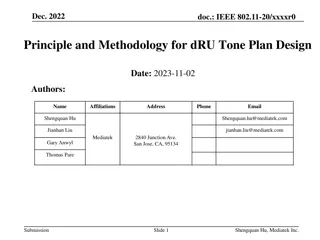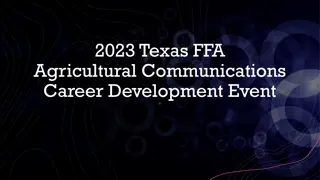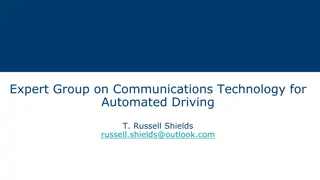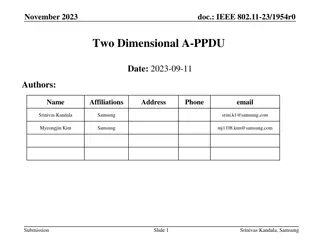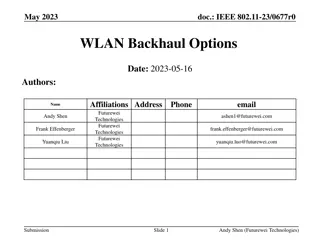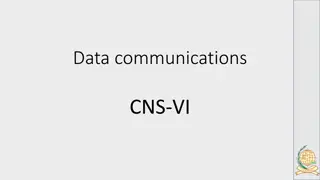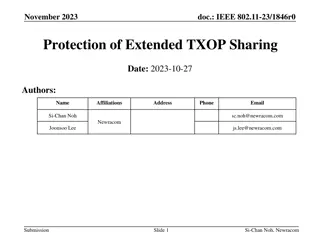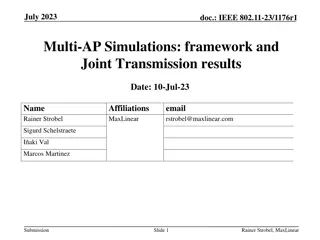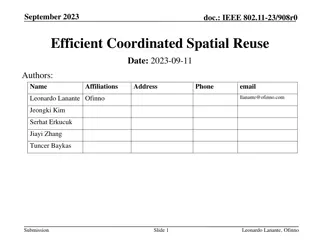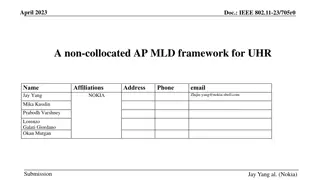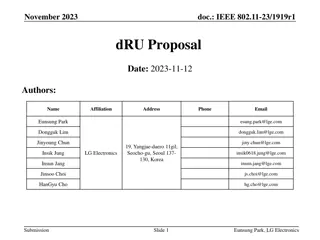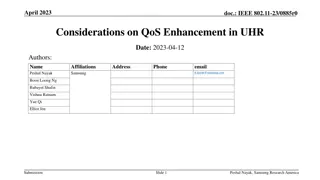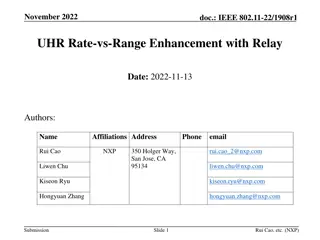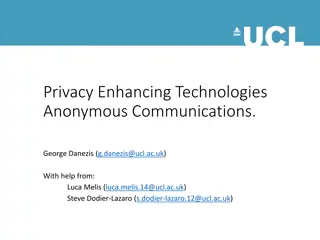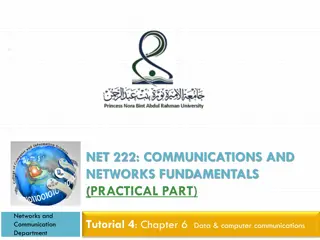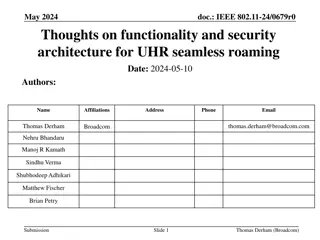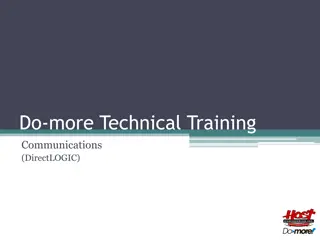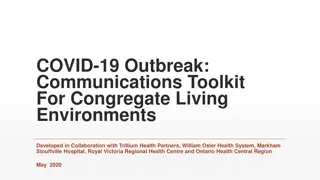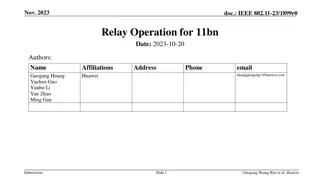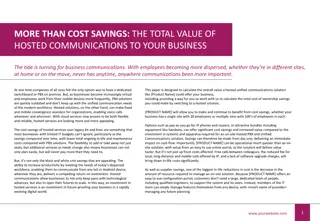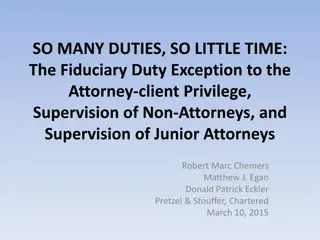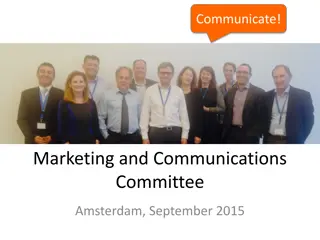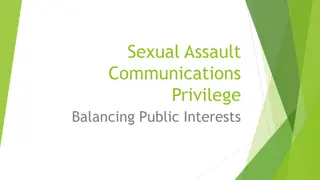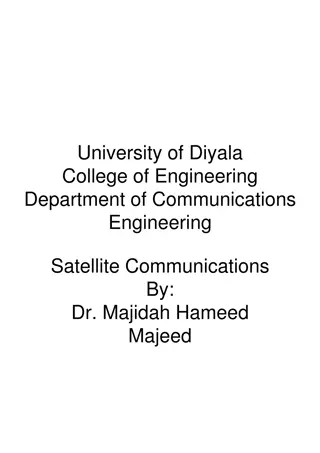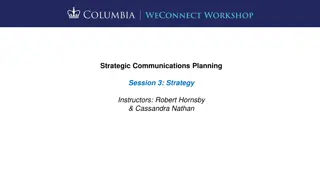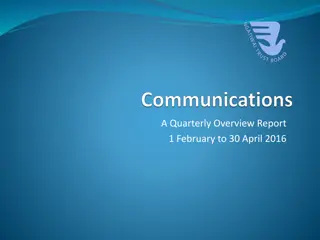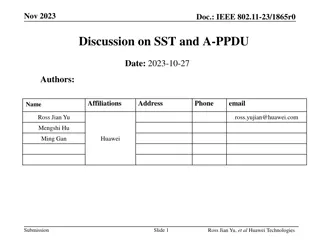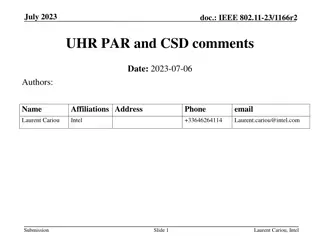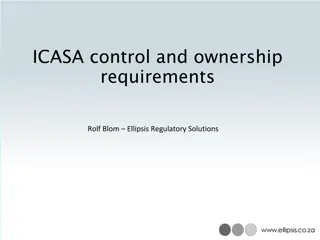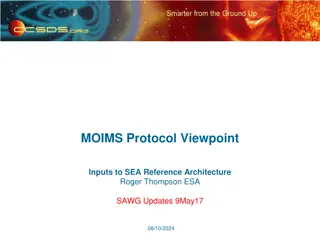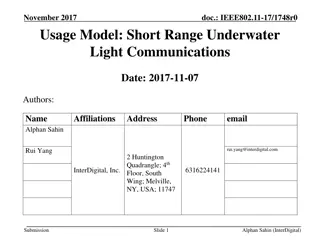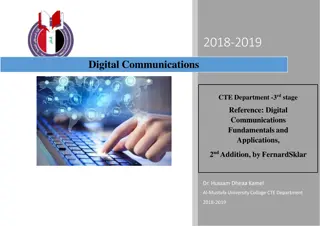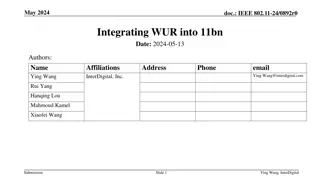Efficient dRU Tone Plan Design for UHR Communications
The document discusses the signaling techniques for Ultra-High Rate (UHR) communications using dRU (dense RU) for overcoming PSD limitations. It elaborates on the methods to construct a dRU tone plan and indicate dRUs within rRUs. The design involves defining different sizes of dRUs, combining tones
0 views • 28 slides
Principle and Methodology for dRU Tone Plan Design in IEEE 802.11-20
Introduction of Distributed Tone RU (dRU) as a potential UHR PHY feature to address PSD limitations for 6GHz LPI and enhance Rate vs. Range performance. Emphasis on dRU tone plan design criteria, methodologies, and performance simulations. Detailed examination of design principles, methods, consider
4 views • 23 slides
Satellite Communications Support for Enhanced Emergency Communications
Providing support for enhanced emergency communications through mobile and fly-away satellite systems. These systems offer cellular-based WiFi, satellite-based WiFi, and voice over IP phone numbers for use during communication disruptions. Satellite airtime is provided at no cost to TxDOT through th
2 views • 4 slides
Texas FFA Agricultural Communications Career Development Event 2023
The 2023 Texas FFA Agricultural Communications Career Development Event offers a comprehensive schedule including team orientation, press conference, quizzes, practicums, and more. Contestants will engage in activities such as a communications quiz, editing exercise, practicum work, and web design.
1 views • 20 slides
CEPT Workshop on 6G Mobile Communications: Numbering & Network Issues
CEPT Workshop on 6G Mobile Communications, led by Elizabeth Greenberg of Ofcom UK, addresses the role of numbering and networks in the ECC, numbering considerations for 6G, and how WG NaN contributes to the development of numbering for 6G technologies. Key topics include ensuring non-discriminatory
1 views • 8 slides
Expert Group on Communications Technology for Automated Driving
The Expert Group on Communications Technology for Automated Driving, established by ITU, focuses on key topics such as V2V communications capabilities, protecting vulnerable road users, and matching service life of communications equipment with automobiles. The group recently had its first meeting t
0 views • 7 slides
Two-Dimensional A-PPDU for Low Latency in UHR Networks
This document discusses the proposed two-dimensional (2D) A-PPDU as a solution for supporting low-latency applications in UHR networks. It delves into the details of 2D A-PPDU for downlink, focusing on the ability to insert PPDUs within a PPDU, aiming to reduce latency in UHR environments by enhanci
0 views • 17 slides
Enhanced Security Considerations in IEEE 802.11-23 for UHR
The document discusses enhanced security considerations for control frames and MAC headers in IEEE 802.11-23 addressing vulnerabilities and proposing encryption/decryption methods. It highlights the need for support for security protocols in control frames and the importance of protecting MAC header
0 views • 13 slides
WLAN Backhaul Options for Next-Generation Wi-Fi Networks
IEEE 802.11-23/0677r0 explores various backhaul options for WLAN, emphasizing Fiber to the Room (FTTR) technology based on Passive Optical Network (PON) for enhancing the performance of multi-AP coordinated next-gen Wi-Fi UHR. The document discusses wired and wireless backhaul connections, including
2 views • 15 slides
Fundamentals of Data Communications: Characteristics and Components
Data communications involve the exchange of data between devices through transmission mediums. The effectiveness of a data communications system relies on key characteristics like delivery, accuracy, timeliness, and jitter. The system components include the message, sender, receiver, transmission me
0 views • 63 slides
Protection of Extended TXOP Sharing in IEEE 802.11-23/1846r0
Reusing EHT's Triggered TXOP Sharing framework for extended TXOP sharing is discussed in this document, focusing on enabling sharing APs to distribute their obtained TXOP among other BSS(s). The document explores issues related to TXOP sharing for UHR STAs when a sharing AP allocates a portion of it
0 views • 12 slides
IEEE 802.11-23/1176r1 Multi-AP Simulations Overview
Detailed exploration of Joint Transmission (JT) simulation results for IEEE 802.11-23/1176r1, emphasizing real-world deployment scenarios in residential settings. The submission discusses topologies, considerations, and initial simulation outcomes, aiming to align with the UHR project goals and opti
0 views • 24 slides
Efficient Coordinated Spatial Reuse in IEEE 802.11-23
Coordinated Spatial Reuse (C-SR) is a Multi-AP transmission technique proposed for UHR networks that enhances efficiency by utilizing RSSI or pathloss feedback instead of complete CSI. This document introduces an efficient protocol for C-SR, focusing on a unified approach for better implementation.
0 views • 10 slides
Improving Latency Performance for Mobile Clients Using Non-Collocated AP MLD Framework
The UHR group aims to enhance latency performance for mobile clients by introducing a non-collocated AP MLD framework. This framework allows seamless transfer of client context between physical APs, improving roaming efficiency and supporting high numbers of links for non-AP MLDs. The proposed solut
2 views • 11 slides
IEEE 802.11-23/1980r1 Coordinated AP-assisted Medium Synchronization Recovery
This document from December 2023 discusses medium synchronization recovery leveraging multi-AP coordination for multi-link devices. It covers features such as Multi-link device (MLD), Multi-link operation (MLO), and Ultra High Reliability (UHR) capability defined in P802.11bn for improvements in rat
0 views • 8 slides
IEEE 802.11-23/1919r1dRU Proposal for Range Extension and RvR Enhancement
This proposal introduces dRU support for 11bn to overcome PSD limitations, enabling range extension and RvR enhancement. It reviews previous dRU contributions in UHR SG and details new proposals including distributed tones across channels, dRU tone plans in different MHz channels, and pilot designs
0 views • 22 slides
Enhancing Quality of Service in Ultra High Rate Wi-Fi Networks
This document explores the potential improvements in Quality of Service (QoS) for Ultra High Rate (UHR) Wi-Fi networks, focusing on the benefits of timing information sharing for traffic urgency assessment. It discusses areas such as increased reliability, lower latencies, improved manageability, an
0 views • 11 slides
Relay Communications for Ultra High Reliability in IEEE 802.11-22/1908r1
Investigating relay communications to enhance Rate-vs-Range (RvR) performance for Ultra High Reliability (UHR) in IEEE 802.11-22/1908r1. The content explores relay design objectives, goodput analysis, existing relay solutions like WiFi extenders, and the challenges in implementing relay technology t
3 views • 16 slides
Enhancing Privacy and Anonymous Communications with Technology
Explore the world of Privacy Enhancing Technologies (PETs) and Anonymous Communications through the work of George Danezis and his team at UCL. Dive into the challenges of network identity, lack of privacy, and weak identifiers in today's digital landscape. Learn about Ethernet and IP packet formats
0 views • 49 slides
Fundamentals of Data and Computer Communications Explained
In this tutorial, we delve into Chapter 6 of data and computer communications, focusing on transmission overhead calculations, asynchronous and synchronous communication comparisons, CRC computation, and character transmission requirements. Learn about start bits, stop bits, control bits, parity bit
1 views • 12 slides
UHR Seamless Roaming: Functionality and Security Architecture Proposal
Discussion on the technical requirements for UHR seamless roaming, focusing on the non-AP MLD state preservation and data exchange context between AP MLDs. Proposing a security architecture based on FT to achieve seamless roaming while cautioning against sharing PTK(SA) across multiple AP MLDs. Emph
0 views • 34 slides
DirectLOGIC Communications Training Overview
Explore the technical training communications for Do-more DirectLOGIC systems, focusing on setting up communication between DL Servers and Clients using built-in Ethernet ports and ECOM100 modules. Learn about communication configurations, memory allocation, and parameter settings to establish effec
0 views • 28 slides
COVID-19 Outbreak Communications Toolkit for Congregate Living Environments
This communications toolkit, developed in collaboration with multiple health organizations, provides guidance and resources for managing communication during a COVID-19 outbreak in congregate living environments. It includes information on processes, notifications, web updates, media relations, key
0 views • 34 slides
IEEE 802.11-23/1899r0 Relay Operation for 11bn - Presentation Summary
In this presentation, the IEEE 802.11-23/1899r0 document discusses relay operations to improve Rate-vs-Range (RvR) performance for UHR. Various potential solutions for implementing a relay protocol in UHR are explored, focusing on enhancing multi-hop channel access delay, end-to-end QoS, and simplif
0 views • 10 slides
Unlocking Total Value with Hosted Communications for Your Business
Business communications are evolving, with hosted solutions offering more than just cost savings. They provide flexibility, productivity enhancements, and future-proofing benefits for businesses of all sizes. Switching to a hosted communications solution like [Product Name] can lead to immediate cos
0 views • 4 slides
Understanding the Fiduciary Duty Exception to Attorney-Client Privilege
Several courts have deliberated on extending attorney-client privilege to protect communications between law firms' in-house counsel seeking advice on handling potential malpractice claims. This exception, known as the fiduciary duty exception, has faced scrutiny and rejection in recent cases, safeg
0 views • 36 slides
Enhancing Alliance Strategy Implementation through Effective Communications
This internal communications session aims to establish a framework for Secretariat communications to assist Members in strengthening the Alliance. Key focuses include aligning with the 2016-2021 Alliance strategy, identifying potential gaps, and devising strategies to address them for improved colla
0 views • 6 slides
Communicate! Marketing and Communications Committee Amsterdam Meeting Summary September 2015
The meeting of the Communicate! Marketing and Communications Committee in Amsterdam focused on various themes such as clean air, public communications, public acceptance, gas innovation, and marketing campaigns. Members discussed cooperation with the IGU Presidency to support clean air campaigns, ra
0 views • 12 slides
Understanding Sexual Assault Communications Privilege and Balancing Public Interests
Exploring the complexities and practical challenges surrounding Sexual Assault Communications Privilege (SACP), this content delves into the reasons for its establishment, the services it provides, and the implications for both defence lawyers and complainants in sexual assault trials. It sheds ligh
0 views • 19 slides
Partnership Internal Communications Plan & Stakeholder Analysis
Developing an effective internal communications plan for a partnership involves drawing insights from stakeholder analysis, drafting, validating, and implementing the plan. Engaging with internal stakeholders, understanding their awareness, engagement levels, and expectations, and prioritizing commu
0 views • 6 slides
Understanding Satellite Communications and Orbits in Engineering
Exploring the intricacies of satellite communications and orbits in engineering, focusing on special types of inclined orbits, circular orbits, elliptic orbits, and the calculation of eccentricity. Examples such as the International Space Station's orbit are used to illustrate concepts. The content
0 views • 17 slides
Understanding Strategic Communications Planning
This content delves into the intricacies of strategic communications planning, covering topics such as defining communication goals, elements of a communications plan, and the importance of strategy in various arenas. The importance of strategy in connecting purpose, audience, and outcomes is emphas
0 views • 22 slides
Quarterly Overview Report: Feb-April 2016 for NTB Communications
Highlights include successful workshops on communication strategy, website revamp, and monthly communications activities. NTB also provided regular updates through newsletters and board meeting summaries. Various other panui were shared via mail, website, and social media. Barry Caldwell is the main
0 views • 4 slides
Discussion on IEEE 802.11-23/1865r0: SST and A-PPDU
The document discusses the current lack of support for SST on S160 in 11be, highlighting that 11be AP and STA do not support A-PPDU. It explores potential combinations for A-PPDU involving UHR and non-UHR HE and EHT STAs, addressing bandwidth enhancements and benefits of various scenarios. The analy
0 views • 14 slides
IEEE 802.11-23 UHR PAR and CSD Comments Review
Reviewing comments and responses on IEEE 802.11-23/1166r2 UHR PAR and CSD focusing on enhancing Ultra High Reliability in Wireless Local Area Networks (WLAN) with clarifications and modifications for project scope and objectives.
0 views • 21 slides
Understanding ICASA Control and Ownership Requirements
In South Africa, the Independent Communications Authority of South Africa (ICASA) regulates the licensing framework for electronic communications services. ICASA's mandate involves establishing licensing frameworks, promoting ownership by historically disadvantaged groups, and supporting black econo
0 views • 14 slides
MOIMS Protocol Viewpoint for SEA Reference Architecture Updates
This content describes the MOIMS Protocol Viewpoint inputs to the SEA Reference Architecture updates by Roger Thompson from ESA SAWG. It includes details about the graphical conventions, data store elements, organizational domains, network layers, communications protocols, and space communications c
0 views • 21 slides
Underwater Light Communications in November 2017
Discusses the advantages of light communications (LC) for underwater use, such as high data rate, low latency, and cost-effectiveness. Contrasts LC with acoustic and RF methods, highlighting benefits and limitations. Explores use cases including communication between submarines, divers, oil platform
0 views • 5 slides
Understanding Digital Communications in CTE Department: Concepts and Applications
In the realm of Digital Communications at the CTE Department, delve into a thorough exploration of fundamental principles and practical applications. Concepts such as television signal transmission, binary PCM, quantization levels, code word lengths, transmission bandwidth, signaling rates, and nois
0 views • 8 slides
Integrating WUR into IEEE 802.11bn for Enhanced Network Efficiency
IEEE 802.11-24/0892r0 proposes integrating Wake-Up Radio (WUR) technology into 11bn networks to improve reliability, support low latency traffic, increase peak throughput, and enhance power-saving capabilities. The WUR acts as a companion radio to the main connectivity radio, enabling power-saving w
0 views • 10 slides

